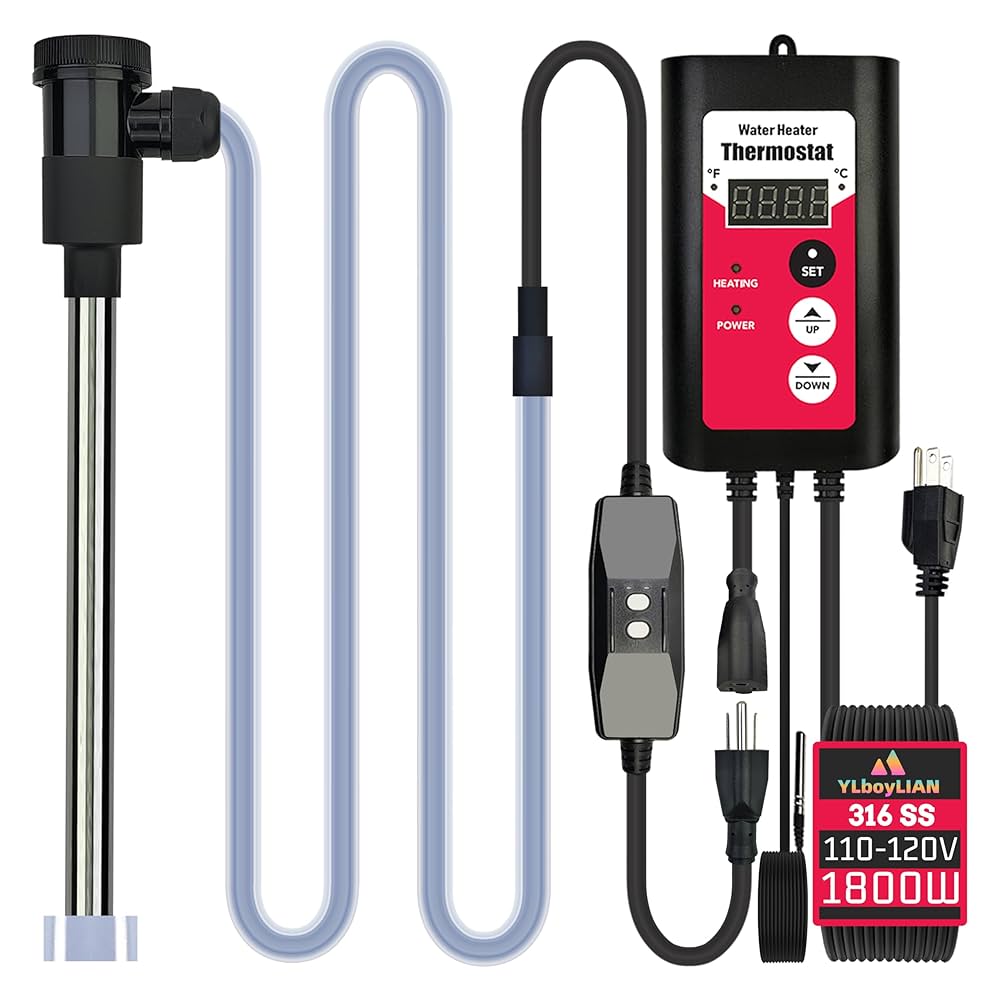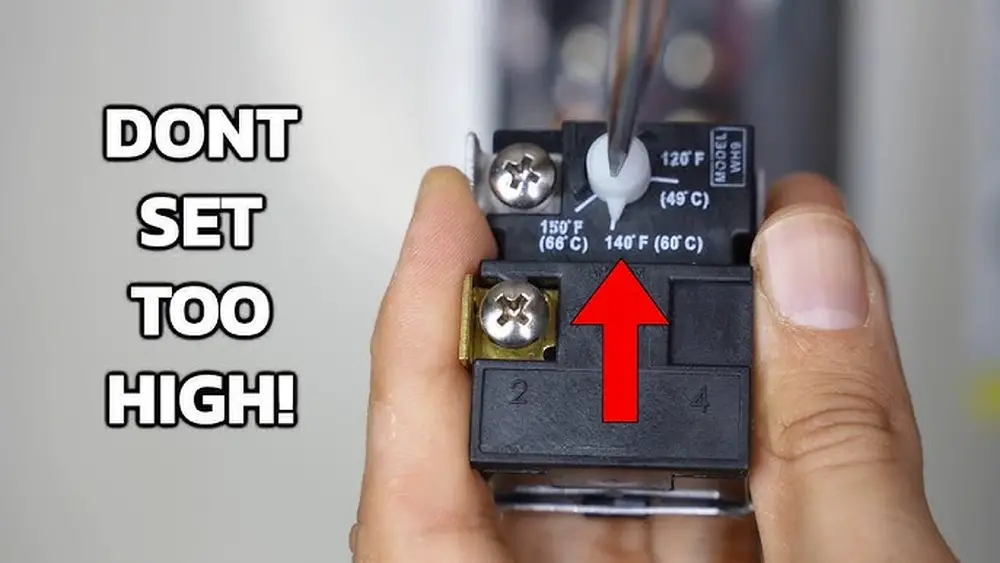Check Best Thermostat Pricing in Amazon
** As an Amazon Associate, I earn from qualifying purchases.
Are you confused about how to set the thermostats on your water heater? You might have noticed there are two dials and wondered if they should be set the same or differently.
Getting this right can save you money, prevent damage, and ensure your hot water stays just right. Keep reading to discover simple tips that will help you optimize your water heater’s performance and avoid common mistakes many homeowners make.
How Dual Thermostats Work
Water heaters with two thermostats have a smart design. They help heat water evenly and save energy. Understanding how these dual thermostats work is key to setting them properly. This section explains what each thermostat does and how they work together.
Role Of Each Thermostat
Each thermostat controls a different heating element. The upper thermostat controls the top heating element. It heats water in the upper part of the tank. The lower thermostat controls the bottom heating element. It heats water in the lower part of the tank. Both thermostats monitor water temperature in their zones. This design helps keep water warm throughout the tank.
Interaction Between Thermostats
The thermostats work in a sequence, not at the same time. The upper thermostat heats water first. It turns on the top heating element until the water is hot. Once the upper zone reaches the set temperature, the lower thermostat takes over. The lower thermostat heats the water at the bottom of the tank. It keeps the tank fully heated and ready to use. This step-by-step action saves energy and prevents overheating.

Credit: www.amazon.com
Benefits Of Matching Temperatures
Setting both thermostats on your water heater to the same temperature has clear advantages. It helps your water heater work smoothly without extra effort. This simple step can make your daily life easier and your home more comfortable.
Matching thermostat settings also protects your water heater from wear and tear. Balanced temperatures mean less strain on the heating elements. This can extend the life of your water heater and save money on repairs.
Energy Efficiency
When both thermostats are set the same, the water heater uses energy wisely. It avoids overheating one part while underheating another. This balance reduces electricity bills and saves energy.
Energy-efficient heating is good for the environment. It lowers your home’s carbon footprint. Small changes like this help reduce waste and pollution.
Consistent Water Temperature
Matching thermostat settings keep your water temperature steady. You get hot water at the same temperature every time. No sudden cold bursts or overly hot water.
This consistency improves comfort in showers and baths. It also protects your skin from scalding. A balanced temperature is safer for families with children.
Risks Of Setting Different Temperatures
Setting different temperatures on the two thermostats of a water heater can cause problems. It may seem like a way to save energy or customize hot water. The risks, however, often outweigh the benefits. Uneven heating and damage to parts are common issues. Understanding these risks helps keep your water heater working well and lasting longer.
Potential For Uneven Heating
Different thermostat settings can cause water to heat unevenly. One part of the tank may be hotter than the other. This leads to inconsistent hot water at taps or showers. You might get cold bursts or scalding water unexpectedly. Uneven heating also reduces comfort and wastes energy. The water heater works harder to balance temperatures inside the tank. This extra work can increase your energy bills over time.
Wear And Tear On Components
Water heaters have parts designed to work together smoothly. Different thermostat settings force these parts to work unevenly. The heating elements may turn on and off at different times. This causes stress and wear on the components. Over time, this can lead to early failure or costly repairs. The thermostat itself can become less accurate. Consistent temperature settings help protect the heater and save money on maintenance.
Manufacturer Recommendations
Manufacturer recommendations provide clear advice on setting thermostats for water heaters. They help ensure safety and efficiency. Following these guidelines can prevent damage and reduce energy costs.
Common Guidelines
Most manufacturers suggest setting both thermostats to the same temperature. This keeps the water heater balanced. Unequal settings can cause the heater to work harder. It may lead to uneven water temperature. Setting both thermostats equally extends the heater’s life.
Check Best Thermostat Pricing in Amazon
** As an Amazon Associate, I earn from qualifying purchases.
Why Following Instructions Matters
Ignoring manufacturer instructions can cause problems. It may void your warranty. The water heater might overheat or underperform. Safety features rely on correct thermostat settings. Proper settings protect your home and family. Following instructions ensures the heater works as designed.
Adjusting Thermostats For Specific Needs
Adjusting thermostats on a water heater helps meet different household needs. Some homes require varied water temperatures for comfort or energy savings. Setting each thermostat separately allows better control of hot water use. It also helps reduce electricity costs by avoiding overheating.
Situations For Different Settings
Families with children might want lower temperatures to prevent burns. Older adults may prefer warmer water for comfort. Some appliances need hotter water, so one thermostat can be set higher. Splitting settings can save energy by heating only what is necessary. It suits homes with different water use patterns.
Safety Precautions
Always keep one thermostat at a safe minimum temperature. Too low settings can cause bacteria growth in the tank. Avoid setting thermostats above 120°F to prevent scalding. Use a thermometer to check water temperature regularly. Turn off power before adjusting thermostats for safety.

Credit: bardi.com
Troubleshooting Temperature Issues
Troubleshooting temperature issues on a water heater is important for comfort and safety. Sometimes, the water is too hot or too cold. Other times, the temperature may change suddenly. These problems often relate to the thermostats. Knowing how to spot thermostat issues helps you fix the problem faster.
Signs Of Thermostat Problems
Uneven water temperature is a common sign of thermostat problems. One thermostat may heat more than the other. Water may feel cold even though the heater runs. You might notice water that is too hot, which can cause burns. Strange noises from the water heater may also indicate thermostat issues. The heater may cycle on and off frequently. These signs show the thermostats need checking.
When To Call A Professional
Some thermostat problems need expert help. If you cannot find the cause of temperature changes, call a professional. Avoid trying to fix electrical parts yourself. A professional can test and replace faulty thermostats safely. They ensure the water heater works efficiently. This prevents damage and keeps your home safe. Calling a professional saves time and stress.

Credit: waterheatertimer.org
Frequently Asked Questions
Should Both Thermostats On Water Heater Be Set The Same?
Yes, setting both thermostats to the same temperature ensures even heating. It prevents uneven water temperatures and reduces energy waste. This balance extends the water heater’s lifespan and improves efficiency.
What Happens If Water Heater Thermostats Are Set Differently?
If thermostats are set differently, water temperature may fluctuate. One part might overheat while the other stays cooler. This causes inefficient heating and may damage the heater over time.
Can Different Thermostat Settings Save Energy On Water Heaters?
No, uneven settings can cause the heater to work harder. This increases energy consumption and utility costs. Consistent settings optimize performance and save energy.
How Do I Adjust Water Heater Thermostats Correctly?
Turn off power before adjusting. Set both thermostats to the recommended temperature, usually 120°F. Use a flathead screwdriver to turn the dial carefully. Always test water temperature after adjustment.
Conclusion
Setting both thermostats on your water heater the same keeps water temperature steady. It helps your heater run smoothly and lasts longer. Different settings can cause uneven heating or damage parts. Keep the temperature at a safe level to avoid burns or energy waste.
Check your manual for the best temperature advice. Simple steps like this save money and keep your home comfortable. Small changes make a big difference.
Check Best Thermostat Pricing in Amazon
** As an Amazon Associate, I earn from qualifying purchases.


